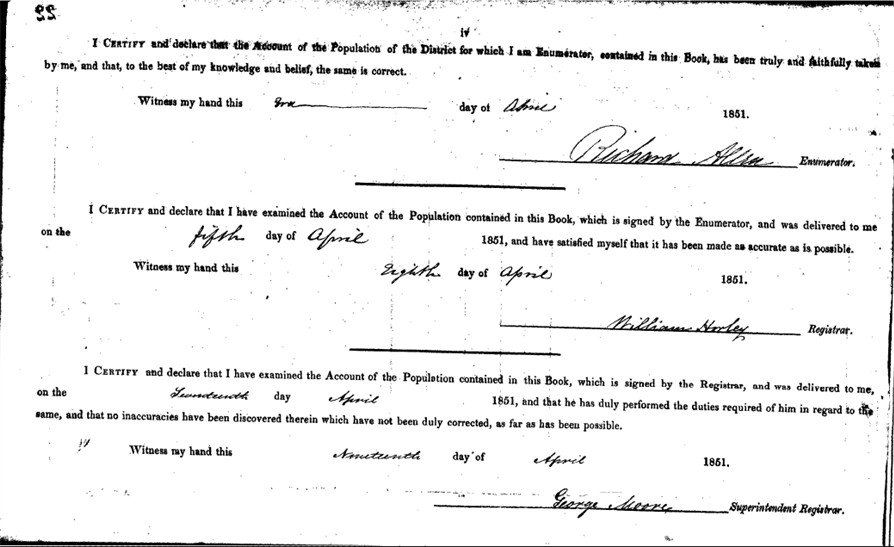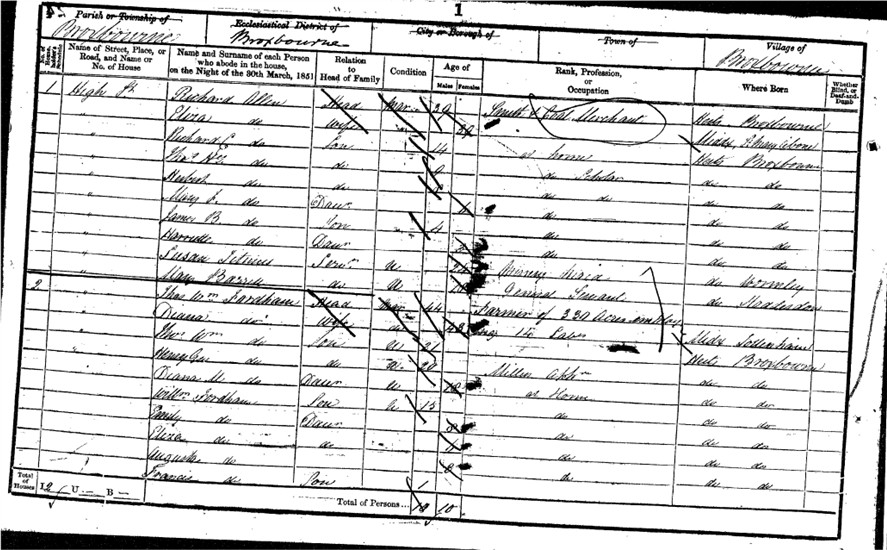1841 Census 1851 Census 1861 Census 1871 Census
1881 Census 1891 Census 1901 Census 1911 Census
But I can't find ... Examples of census problems
Census Indexes Sources compared
The Census and Maps Census Humour
Estimating Date of Birth from Census Returns
The Use of Censuses in Primary Schools
Population Movement in Rural Hertfordshire
Introduction
The UK census has been taken at ten year intervals since 1801. The censuses for 1801, 1811, 1821 and 1831 did not record names and the census returns of interest to genealogists were taken on 6 June 1841, 30 March 1851, 7 April 1861, 2 April 1871, 3 April 1881, 5 April 1891 and 31 March 1901. The census returns less than 100 years old are not available.
The 1841 census records, for each household the name, age (rounded down to the nearest term of 5 if over 14 years), sex, profession/trade/employment, and whether they were born in the same county (yes/no) or born in Scotland, Ireland or Foreign Parts. No information is recorded about the relationship between the members of the household. This is described in more detail on the 1841 census page.
The other census returns all have a similar form, although there are small differences, particularly when distinguishing between employers and employees. The following is based on examples from the 1851 census, with notes on the differences where relevant.
At the start of each book there is a description of the Enumeration District:

The header boxes include the County and Parliamentary Division, the Superintendent Registrar's District, The Registrar's District, and the number of the Enumeration District.
In Hertfordshire the censuses were based on the Poor Law Unions - and as Unions crossed county boundaries parishes adjacent to a county boundary can sometimes appear in the "wrong" county. See The Poor Law Unions of Hertfordshire.
There is then a description of the Enumeration District. This is free format and not only records the area covered but also indicates the order in which the households are recorded. In a very few case a sketch map of the district has been included.
By defining the district this can indicate whether a particular address is covered by the enumeration book, and can be very useful in tracking down the location of a property, for instance by indicating which way the enumerator passed along the "High Street" and which side of the road he was on.. See Locating Census Addresses on Maps.
The book then contains some pages used in statistical analysis of no immediate relevance to the family historian.
Next come a page recording who carried out the census.

This page is often overlooked by genealogists - but the enumerator was usually a local man who was both literate and numerate (and who was probably well known in the district - so much for perceived confidentiality). It could be that the enumerator (or for that matter the registrar or superintendent registrar) could be a relative of yours - providing you with an example of his signature.
This is followed by the enumeration pages proper. The Header boxes identify the place under various headings, followed by the detailed returns.

The boxes are as follows:
|
Number of Schedule |
(The only use to the genealogist is that a new number is a new household - it must not be thought of as a house number.) |
|
Address |
The name of the place, street or road, and name or number of house. Sometimes these are not very specific - such as "village" |
|
House inhabited |
Not 1851 - an indication of whether the building was occupied, unoccupied or being built. |
|
Name & Surname |
This first name may be a nickname rather than the given name, and multiple given names may not be recorded or given only as initials. "do" (for ditto) regularly used for the surname - but is normally expanded in indexes and transcripts. This means that if there is a transcription error in the surname it is copied to all members of the family. |
|
Relation to Head |
The relationship to the head of household. |
|
Condition |
Marital status (M - married, U - unmarried, Widower, Widow) Left blank for children |
|
Age and Sex |
When processing the statistics a check mark was often made in the "age" box - and this can obliterate the age. If this happens it helps to know that children in a single family are listed in date of birth order, eldest first. |
|
Rank, Profession or Occupation |
When processing the statistics additional information was sometimes written in - sometimes in brackets - to allow the data to be categorised. "Dom" is often used to indicate that the individual was employed as a domestic servant. If the individual had a very specialised occupation the added note can indicate the industry involved. |
|
Employer, etc |
In the earlier census this was recorded as part of the occupation - and in the case of a farmer both the size of the farm and the number of employees was written in. In the 1891 the employment status is specifically recorded, with different arrangements in 1901. |
|
Where born |
Place and County, or Country. The place is normally the parish or town or village where the individual was born. However there was no check - and in some cases the place may be a small hamlet or even an single farm! |
|
Disability |
Blind/deaf & dumb - 1871 onwards also idiot and lunatic |
Enumerators would ensure that a schedule was completed for each household, if necessary by asking questions and completing the form if the householder was illiterate. The information from these household schedules would then be copied into the enumerators book, which would start with a description of the area covered by the return, in the order the households were visited. Statistical information was then extracted and occasionally additions would be made to the occupation to clarify the meaning in the statistical summary. The original household schedules were destroyed and the books stored for 100 years when they were made available for public inspection. Because of the great interest from genealogists the books would not stand the wear and tear of repeated handling and they were made available on microfilm, but are now available on CD and online.
As alternatives to online searching, or buying a CD, the census returns can be viewed at the Family Records Centre, in London, The census films can be ordered for a small fee at any LDS Family History Centre (see familysearch for addresses) so are readily available to anyone world-wide. Within Hertfordshire there is a complete set of Hertfordshire microfilms at HALS, County Hall, Hertford. Many of the larger Hertfordshire libraries also have copies of the films for their locality that can be accessed free although a high charge is made for photocopies. However some libraries only have one microfilm reader so one needs to book in advance.
Availability of Online Records
All censuses are now available online (in many cases on a commercial basis) as indexes and images, and details of sources for the county are given on the individual census pages, Transcripts for individual towns or villages are listed on the appropriate place page.
1841 Census 1851 Census 1861 Census 1871 Census
1881 Census 1891 Census 1901 Census 1911 Census
The 1921 census will not become available to 2022
The 1939 Register becomes available on FindMyPast in November 2015
Problem Solving
Page updated July 2007